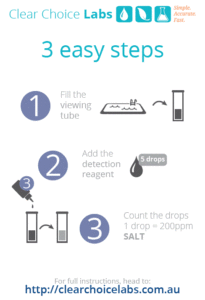Instructions
How to Test for Salt using a Drop Test
Unless your pool has a salt water generator (SWG), it is unnecessary to test for salt levels in your pool. SWGs consume the salt in the pool to turn into free chlorine, meaning that daily addition of chlorine is unnecessary. Most SWGs have a broad range of operation (the difference between the “too little salt” point and the “too much salt” point), but it’s important to keep the salt within that range. Too little salt means your SWG cannot produce enough chlorine for your pool, too much salt and you can risk damaging your SWG.
The instructions on the sides of our kits are simplified reminders of the procedure for advanced users. These are the extended instructions for the Salt Water Test Kit, that give you all the needed details on how to test your pool for salt levels.
To ensure your kit is working, we have included a salt standard of 4000ppm. When you use this standard instead of pool water, your test should read 4000ppm. It is not necessary to use this at all, however it can provide reassurance if you are new to testing, or you think you may have damaged your hydrometer.
Standard Test
 Place the bench protector where you intend to do the test. Wear the protective gloves provided.Rinse the salt viewing tube with pool water.
Place the bench protector where you intend to do the test. Wear the protective gloves provided.Rinse the salt viewing tube with pool water.- Note: You should read and understand the SDS(s) available online before using this kit.
- Fill the salt viewing tube with pool water to the mark indicated (lower line).
- Add five (5) drops of the salt detection reagent, and mix well. Replace the lid on the reagent immediately to extend the life of your kit.
- One drop at a time, add the salt titrating reagent. Mix between each drop, and count the total number of drops added until the colour changes first changes from a milky yellow to a milky red.
- Note: Do not add so much salt titrating reagent that the reaction turns brown. This will lead to an overestimate of the salt concentration.
- Note: Always hold the titrating reagent vertically, and allow full size drops to form with as little squeezing as possible. This will ensure the greatest possible accuracy.
- Multiply the number of drops by 200 to get your salt level in parts per million (ppm).
- Dispose of the sample safely. Do not pour the sample and chemicals back into the pool, instead
pour down the sink with lots of running water. - Rinse the salt water viewing tube with tap water. Clean the tube with a gloved finger to make sure that any precipitate is not left on the tube surface.
- Store the kit in a cool, dark, and dry place.
High Sensitivity Test
- Place the bench protector where you intend to do the test. Wear the protective gloves provided.Rinse the salt viewing tube with pool water.
- Note: You should read and understand the SDS(s) available online before using this kit.
- Fill the salt viewing tube with pool water to the mark indicated (lower line).
- Add twelve (12) drops of the salt detection reagent, and mix well. Replace the lid on the reagent immediately to extend the life of your kit.
- One drop at a time, add the salt titrating reagent. Mix between each drop, and count the total number of drops added until the colour changes first changes from a milky yellow to a milky red.
- Note: Do not add so much salt titrating reagent that the reaction turns brown. This will lead to an overestimate of the salt concentration.
- Note: Always hold the titrating reagent vertically, and allow full size drops to form with as little squeezing as possible. This will ensure the greatest possible accuracy.
- Multiply the number of drops by 80 to get your salt level in parts per million (ppm).
- Dispose of the sample safely. Do not pour the sample and chemicals back into the pool, instead
pour down the sink with lots of running water. - Rinse the salt water viewing tube with tap water. Clean the tube with a gloved finger to make sure that any precipitate is not left on the tube surface.
- Store the kit in a cool, dark, and dry place.
Want a printable version of these instructions? We have you covered!
